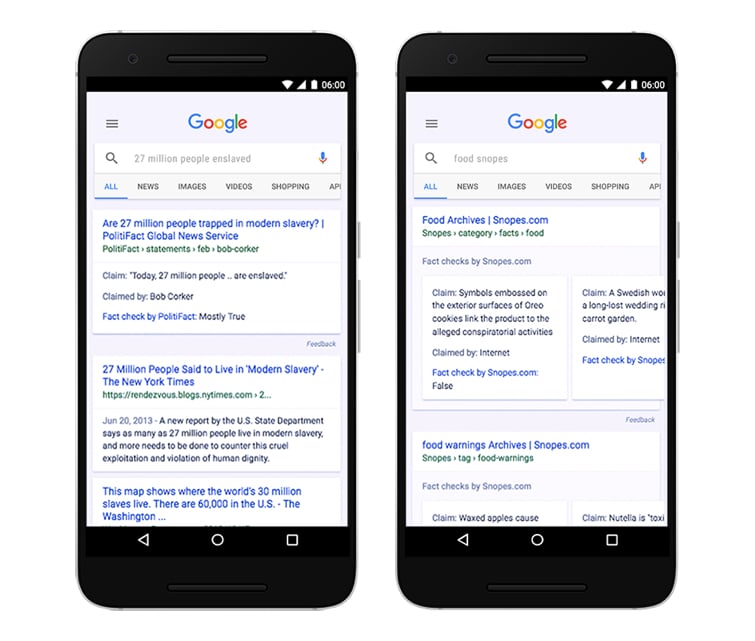
Google Fact Check to Face Off with Fake News
Publishing misinformation is no new practice — the term ‘Yellow Journalism’ was coined in the 1890s to describe sensationalist news articles that contained little to no research and whose intent was sometimes political gain or to confuse its readers. Because of its resurgence in the form of ‘Fake News,’ Google has enacted a new Fact Check feature that formats search results so that users can quickly determine whether or not a popularly-disputed claim is credible or not. The result will show a “claim,” “claimed by,” and “fact check,” which provides the correct answer to the claim as well as the source it came from.
 An example of a Google Fact Check result. Image from Google Blog
An example of a Google Fact Check result. Image from Google Blog
This change came following waves of negative press when Google’s featured snippets (fact boxes shown above results) and top search results offered some dodgy answers — even reading them aloud as facts to users of their voice-driven product Google Home. After labeling Republicans Nazis, suggesting that four U.S. Presidents were members of the KKK, categorically denigrating women, and providing a Holocaust-denying Neo-Nazi site as a top result to a Holocaust query, it's easy to see why Google would be eager to join other tech companies in attempting to distinguish fake and real news stories for their users. They’ve stated in the Google Development blog: “Even though differing conclusions may be presented, we think it’s still helpful for people to understand the degree of consensus around a particular claim and have clear information on which sources agree. As we make fact checks more visible in Search results, we believe people will have an easier time reviewing and assessing these fact checks, and making their own informed opinions.”

This change came following waves of negative press when Google’s featured snippets (fact boxes shown above results) and top search results offered some dodgy answers — even reading them aloud as facts to users of their voice-driven product Google Home. After labeling Republicans Nazis, suggesting that four U.S. Presidents were members of the KKK, categorically denigrating women, and providing a Holocaust-denying Neo-Nazi site as a top result to a Holocaust query, it's easy to see why Google would be eager to join other tech companies in attempting to distinguish fake and real news stories for their users. They’ve stated in the Google Development blog: “Even though differing conclusions may be presented, we think it’s still helpful for people to understand the degree of consensus around a particular claim and have clear information on which sources agree. As we make fact checks more visible in Search results, we believe people will have an easier time reviewing and assessing these fact checks, and making their own informed opinions.”
How it works:
If you own a website that reviews claims, you can include a ClaimReview schema tag in your webpage so that it appears in these specially-formatted Google results. Google will use their algorithm to determine which sites are credible and ignore those who aren’t, even if the site contains a ClaimReview markup. Here are a few tips that will help your chances of appearing in claims relevant to your site:
If you believe your site provides reputable answers to commonly-searched-for claims and want more information, give us a call! We can help you best position yourself as a source for inquisitive minds.
If you own a website that reviews claims, you can include a ClaimReview schema tag in your webpage so that it appears in these specially-formatted Google results. Google will use their algorithm to determine which sites are credible and ignore those who aren’t, even if the site contains a ClaimReview markup. Here are a few tips that will help your chances of appearing in claims relevant to your site:
- Be transparent about the information you provide by using ClaimReview’s rating property (-1 = Hard to categorize, 1 = False, 2 = Mostly false, 3 = Half true, 4 = Mostly true, 5 = TrueP).
- Use Google’s data testing tool to ensure your tag is working.
- Make sure your answer to the claim meets Google’s Fact Check requirements.
- For best results, use only one ClaimReview tag per webpage.
If you believe your site provides reputable answers to commonly-searched-for claims and want more information, give us a call! We can help you best position yourself as a source for inquisitive minds.

